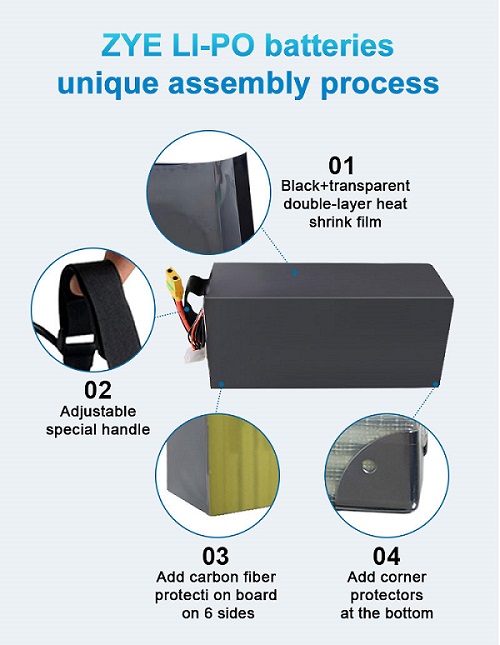The Environmental Impact of LiPo Batteries
2025-06-04
Lithium Polymer (LiPo) batteries have revolutionized portable power solutions across various industries. Their high energy density, lightweight design, and versatility have made them a popular choice for everything from smartphones to drones. However, as with any technology, it's crucial to consider the environmental implications of their production, use, and disposal. In this comprehensive guide, we'll explore the environmental impact of LiPo batteries, their recyclability, toxicity, and proper disposal methods.
Are LiPo batteries recyclable?
The recyclability of LiPo batteries is a topic of growing importance as the demand for these power sources continues to increase. While these batteries can be recycled, the process is not as straightforward as recycling other materials like paper or plastic.
The challenges of recycling LiPo batteries
Recycling LiPo batteries presents several challenges:
Complex composition: LiPo batteries contain multiple materials, including lithium, cobalt, nickel, and various polymers, making separation difficult.
Safety concerns: The flammable nature of lithium poses risks during the recycling process.
Limited infrastructure: Many regions lack specialized facilities equipped to handle LiPo battery recycling.
Current recycling methods
Despite these challenges, progress is being made in LiPo battery recycling:
Hydrometallurgical processing: This method uses aqueous solutions to extract valuable metals from the batteries.
Pyrometallurgical processing: High temperatures are used to recover metals, though this method can result in the loss of some materials.
Direct recycling: This emerging technique aims to preserve the cathode structure, potentially reducing the energy required for recycling.
While these methods show promise, the recycling rate for LiPo batteries remains relatively low compared to other battery types. However, as technology advances and environmental concerns grow, we can expect to see improvements in recycling efficiency and accessibility.
How toxic are LiPo batteries to the environment?
The environmental toxicity of LiPo batteries is a complex issue that requires careful consideration. While these batteries offer significant advantages in terms of performance, their potential environmental impact cannot be ignored.
Toxicity during production
The production of LiPo batteries involves several processes that can have environmental consequences:
Mining: Extraction of lithium and other metals can lead to habitat destruction and water pollution.
Chemical processing: The use of toxic solvents and electrolytes in battery manufacturing can result in hazardous waste.
Energy consumption: The production process is energy-intensive, potentially contributing to carbon emissions if non-renewable energy sources are used.
Environmental impact during use
During their operational life, LiPo batteries generally have a low direct environmental impact. However, indirect effects can occur:
Energy source: The environmental footprint of charging LiPo batteries depends on the cleanliness of the electricity grid.
Lifespan: Shorter battery life can lead to increased production and disposal, amplifying environmental impacts.
End-of-life toxicity concerns
The most significant environmental risks associated with LiPo batteries often occur at the end of their life cycle:
Landfill contamination: When improperly disposed of in landfills, LiPo batteries can leak toxic substances into soil and groundwater.
Incineration hazards: Burning LiPo batteries can release harmful gases and contribute to air pollution.
Resource depletion: Failure to recycle these batteries results in the loss of valuable and finite resources.
While LiPo batteries do pose environmental risks, it's important to note that their overall impact can be mitigated through responsible production, use, and disposal practices. As technology advances, we're seeing improvements in battery longevity, recyclability, and the development of more environmentally friendly alternatives.

Proper disposal guidelines for used LiPo batteries
Proper disposal of LiPo batteries is crucial for minimizing their environmental impact and ensuring safety. Following the correct procedures can help prevent pollution, conserve resources, and reduce the risk of accidents.
Steps for safe LiPo battery disposal
Discharge the battery: Safely discharge the LiPo battery to a low voltage (around 3.0V per cell) using a LiPo discharger or a resistor load.
Insulate terminals: Cover the battery terminals with electrical tape to prevent short circuits.
Place in a non-conductive container: Store the discharged battery in a plastic bag or container to provide an additional layer of protection.
Locate a proper disposal facility: Find a certified battery recycling center or electronics store that accepts LiPo batteries for recycling.
Transport safely: When transporting batteries for disposal, keep them in a fireproof container and avoid exposing them to extreme temperatures.
What not to do when disposing of LiPo batteries
To ensure safety and environmental protection, avoid these common mistakes:
1. Never throw LiPo batteries in regular trash or recycling bins.
2. Don't puncture, crush, or intentionally damage the battery.
3. Avoid exposing the battery to water or other liquids during disposal.
4. Don't attempt to disassemble the battery yourself.
The role of manufacturers and retailers
Many manufacturers and retailers are taking steps to facilitate proper LiPo battery disposal:
Take-back programs: Some companies offer recycling services for their products' batteries.
Collection points: Certain retailers provide drop-off locations for used batteries.
Educational initiatives: Manufacturers are increasingly providing information on proper disposal methods with their products.
By following these guidelines and staying informed about local recycling options, consumers can play a crucial role in minimizing the environmental impact of LiPo batteries.
Conclusion
The environmental impact of LiPo batteries is a multifaceted issue that requires attention from manufacturers, consumers, and policymakers alike. While these batteries offer significant advantages in terms of performance and energy density, their production, use, and disposal can have substantial environmental consequences if not managed properly.
As we continue to rely on LiPo batteries for various applications, it's crucial to prioritize sustainable practices throughout their lifecycle. This includes improving production methods to reduce environmental impact, extending battery life to minimize waste, and implementing effective recycling programs to recover valuable materials.
Consumers play a vital role in this process by following proper usage and disposal guidelines. By being mindful of how we use and dispose of LiPo batteries, we can collectively work towards minimizing their environmental footprint.
As technology advances, we can expect to see improvements in battery design, recycling methods, and the development of more environmentally friendly alternatives. However, until then, responsible management of LiPo batteries remains crucial for balancing technological progress with environmental protection.
If you're looking for high-quality, environmentally responsible LiPo batteries, consider Ebattery's range of products. Our commitment to sustainability and performance ensures that you get the power you need while minimizing environmental impact. For more information or to discuss your specific battery needs, please contact us at cathy@zyepower.com.
References
1. Smith, J. (2022). "The Life Cycle Analysis of Lithium Polymer Batteries". Journal of Sustainable Energy Technologies.
2. Green, A. et al. (2021). "Advancements in LiPo Battery Recycling Techniques". Environmental Science & Technology.
3. Johnson, M. (2023). "Comparative Toxicity of Battery Technologies". Environmental Health Perspectives.
4. Wang, L. and Chen, Y. (2022). "Best Practices for LiPo Battery Disposal and Recycling". Waste Management & Research.
5. Brown, K. (2023). "The Future of Sustainable Battery Technologies". Renewable and Sustainable Energy Reviews.
























































